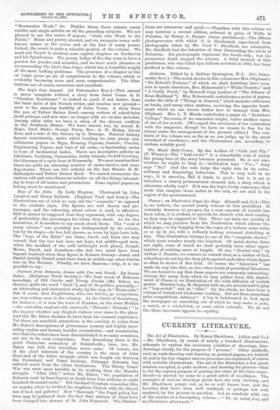Pictures from Bohemia, drawn with Pen and Pencil. By James
Baker. (Religious Tract Society.)—We hear much of Bohemia nowadays, of Old Czechs and Young Czechs (Mr. Baker, we observe, spells the word " Cech "), and of its politics generally,— an interesting and instructive study, by the way, in "Home-rule." But it seems that Englishmen, who, one thinks, go everywhere, are very seldom seen in the country. At the Castle of Rosenburg, for instance—it is near the town of Krumau, on the river Moldau —the custodian emphatically answered, " Niemals I Niemals " to the inquiry whether any English visitors ever came to the place. And this Mr. Baker declares to have been his common experience. Yet there are manifold attractions in the country, to judge from Mr. Baker's descriptions of picturesque scenery and highly inter- esting castles and towers, besides monasteries,—and monasteries, now that the orders have been disestablished in so many countries, are not to be seen everywhere. Near Rosenburg there is the great Cistercian monastery of Hohenfurth ; here, too, Mr.
Baker was told that travellers never came. Of course, one of the chief interests of the country is the story of John
Huss and of the bitter struggle which was fought out between the Protestant and Papal factions. Unhappy Bohemia has suffered much from the odium theologicum. The Thirty Years' War was even more terrible in its working than the Hussite
struggle. "After 1027," writes Mr. Baker, "the population of Bohemia sank by banishment or death from four millions to eight
hundred thousand souls." Did Cardinal Vaughan remember this, we wonder, when he twitted the Anglican Church with the liberal use of lack and gallows P How " thorough " the Papal policy has been may begathered from the fact that statues of Huss have been changed into statues of St. John Nepomuk. The illustra-
tions are numerous and good. Together with this volume we
may mention a second edition, reduced in price, of Walks in. Palestine, by Henry A. Harper (same publishers).—The fifteen photogravures with which it is illustrated, reproduced from photographs taken by Mr. Cecil V. Shadbolt, are admirable. Mr. Shadbolt had the intention of thus illustrating the whole of Palestine. His photographs represent the South only ; but his premature death stopped the scheme. A brief memoir of this gentleman, who was killed by a balloon accident in 1892, has been prefixed to this volume.


















































 Previous page
Previous page